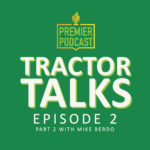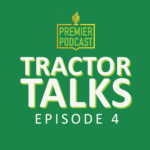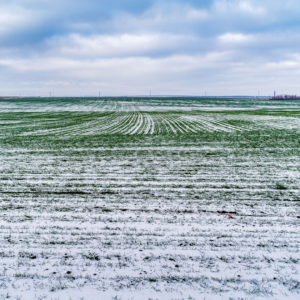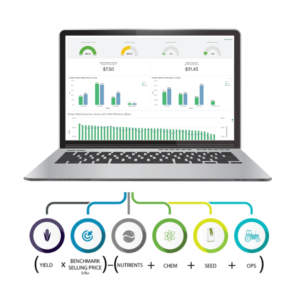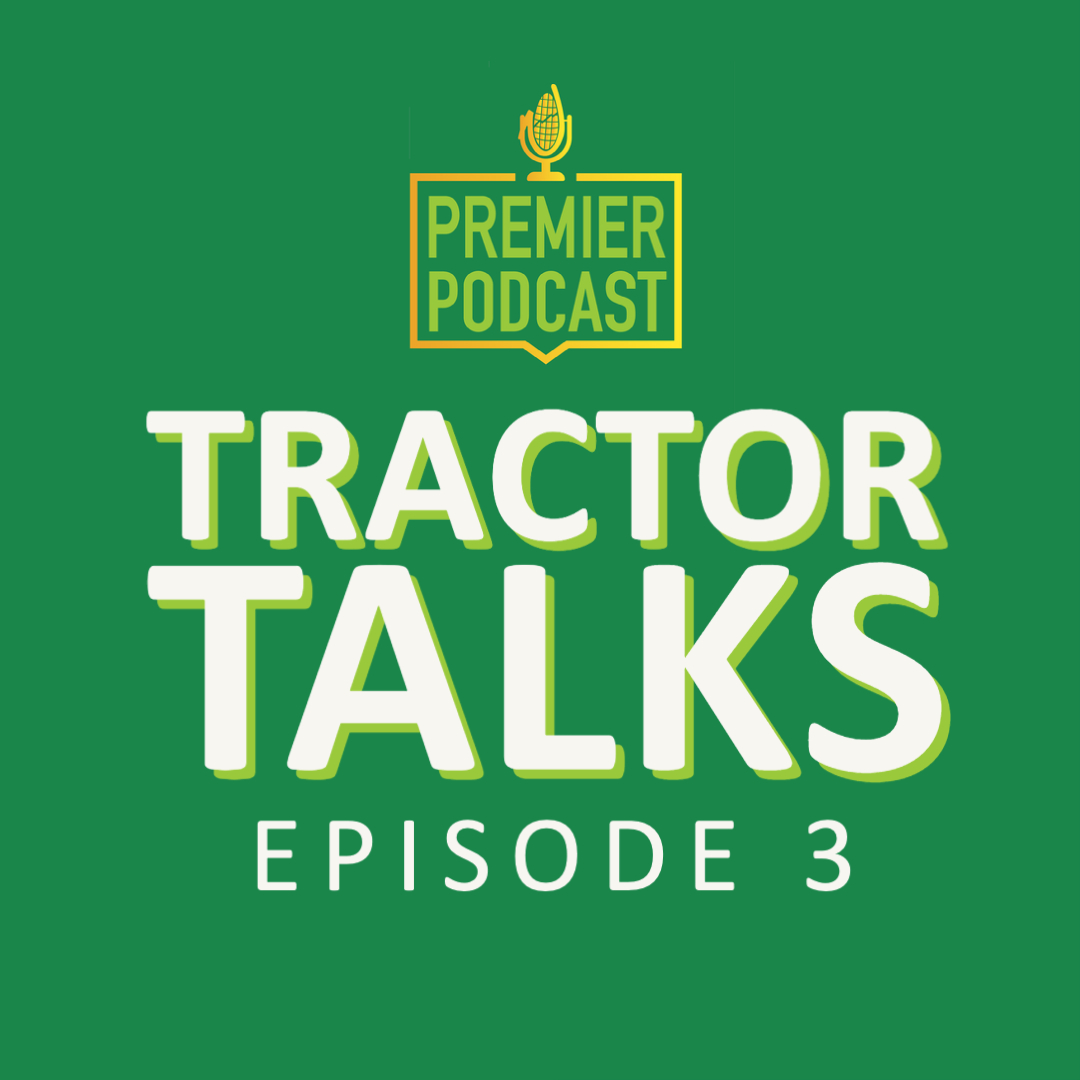
Tractor Talks is a mini series here on the Premier Podcast where we join growers in their tractor cabs during the spring and hear candid thoughts on implementing precision ag.
This series is hosted by Katie McWhirter, Manager of Training and Development at Premier Crop Systems.
If you are enjoying the show, tweet us using #PremierPodcast.
RENEE HANSEN: Welcome to the Premier Podcast miniseries ‘Tractor Talks.’ This is a series comprised of talks in the tractor cab with one of Premier Crop’s advisors, Katie McWhirter, and growers as they are planting this spring. Listen to what their real, honest thoughts are when it comes to nitrogen management, technology and precision ag.
KATIE MCWHIRTER: Tell me your name.
JASON: Jason.
KATIE MCWHIRTER: Okay, so how long have you been farming?
JASON: 27 years.
KATIE MCWHIRTER: Okay. So, as far as precision capabilities, when did you start implementing precision ag?
JASON: 20 years ago.
KATIE MCWHIRTER: And why? What made you decide?
JASON: Save on inputs and expenses.
KATIE MCWHIRTER: Okay, so what was the first thing that you used or switched to or tried out?
JASON: Well, grid sampling and variable-rate fertilizer and also probably sprayer shut-offs would have been the first things.
KATIE MCWHIRTER: Were you skeptical?
JASON: I guess it worried me. The shut-offs scared me at first because I was afraid we would miss something, but they’re way smarter than we are. And it works much better. Computers are way smarter than we are, way more accurate.
KATIE MCWHIRTER: So, then where did you evolve to?
JASON: So, row shut-offs were probably next, and then probably auto-steer after that.
KATIE MCWHIRTER: So, what benefits did you see from those?
JASON: Well, we used to always use too much seed corn because our fields have a lot of point rows. And as soon as we started using row shut-offs, if you needed 17 bags of corn for a field, that’s what you use. You didn’t use 18 or 19 or whatever else.
KATIE MCWHIRTER: So, what are you currently doing? All those things. Anything else?
JASON: Yeah, variable-rate planting.
KATIE MCWHIRTER: Okay, and what benefits have you seen from that?
JASON: A lot of seed savings.
KATIE MCWHIRTER: Okay. Corn? Soybeans? Both?
JASON: Both. I would say our seeding rate is down probably 2500 seeds an acre from what we would have planted when we were flat-rating everything. And our beans are probably down 40,000.
KATIE MCWHIRTER: Wow.
JASON: And we keep dropping that.
KATIE MCWHIRTER: So, you keep dropping it because you’re not giving up yield? Or you’re looking at yield? Or you’re looking at profitability as far as the measurement of success?
JASON: We can’t see that we’re dropping off any yield by lowering our rate as long as we get them spaced right. Get them in the ground right. We went back to a planter instead of a drill. Better placement and spacing.
KATIE MCWHIRTER: Okay. All right, and what are you running on half your planter? What are you testing out now?
JASON: FurrowJets. Precision Planting’s FurrowJets.
KATIE MCWHIRTER: And what are they supposed to do?
JASON: It’s dividing fertilizer up into three spots instead of just one in-furrow spot. We’re hoping it’s going to help break up sidewall compaction.
KATIE MCWHIRTER: So, what’s the next thing for you? Technology or precision? What’s next?
JASON: Well, we’re looking at some other planter attachments. Other than planter attachments, I don’t know that we’re going to buy anything else. Right now, we just probably tweak what we’re doing.
KATIE MCWHIRTER: Okay, would you say that you go into the season with a pretty definite plan of what you’re going to do on each field?
JASON: Well, we always plan for a big crop.
KATIE MCWHIRTER: Okay.
JASON: We don’t plan for failure ever.
KATIE MCWHIRTER: Right. So, what makes you decide to alter from your plan, if you alter? Maybe you don’t.
JASON: I guess if we need something in season, we’ll do it. We use fungicide on all of our corn. Whether they say we need it or not, we’ve been doing it all because we think it pays. And last year, actually, we did fungicide and foliar fed all of our beans. Probably continue doing that. That one’s a questionable one probably on the year.
KATIE MCWHIRTER: Okay.
JASON: I mean, we don’t side-dress as a rule, but if we need to, we will.
KATIE MCWHIRTER: And what makes that determination?
JASON: Weather, probably. We have enough out here already, unless we need to supplement it later.
KATIE MCWHIRTER: So, do you test to know that you’re going to need more, that you should side-dress? Or what?
JASON: If they regulate it, they say it would be too low of rates. My dad loves the anhydrous, and he loves to pour it on.
KATIE MCWHIRTER: Nitrogen’s sexy, right? So, you like a generous estimate.
JASON: Right. Yeah, it is. And I was trying to spread my hog manure out and just putting out what I needed, but I got tired of him out-yielding me. So, now I’m pouring it on too. Are you going to go cheat the poor part of the field because it doesn’t have a history of yielding as well as the rest? You’re going to not feed it as well?
KATIE MCWHIRTER: No, but do you actually need more in those areas because your nitrogen efficiency is going to be better in your higher organic matter areas?
JASON: Well, so, shouldn’t it compensate? It’s probably not going to yield as much, so it probably doesn’t need quite as much in the poorer yield. So, you already kind of are, right?
KATIE MCWHIRTER: Or is it a matter of timing? Right? I mean, so, essentially, you need to come back with extra in those areas. It’s a good conversation.
JASON: It is.
KATIE MCWHIRTER: This is going to make a wonderful podcast.
JASON: It is. So, you’ve seen our fields. They’re up and down and around.
KATIE MCWHIRTER: Agreed.
JASON: The logistics of that are sort of difficult. You’re going to have to drive the whole field to get a certain spot, you know what I mean? To get the right spots, you’re basically going to have to go over the whole field.
KATIE MCWHIRTER: So, you typically wouldn’t come back and side dress?
JASON: We don’t, typically.
KATIE MCWHIRTER: Okay. Both of my other recordings have said they think the next thing for them or the next big thing, not necessarily for them but eventually, is autonomous. So, what are your thoughts on that? Your face got funny on that. So, two different trains of thought on that. The one I rode with yesterday talked about ‘autonomous’ for him because as far as, from an operation standpoint and workforce, he just can’t get labor to assist. I mean, I think about it, and your dad’s just pulling in. We should be recording this with video. I mean, your dad’s 70. Your son’s 13, so it’s going to be a little while, right? So, how do you fill that need for labor? And does autonomous capture that? Or does it assist with that?
JASON: I mean, autonomous sounds great. I guess it’s no different than me planting corn when I’m sleeping.
KATIE MCWHIRTER: Right. Or you just let it drive itself, right?
JASON: Right. I mean, when I’m sitting in here, and I’m sleeping anyway.
KATIE MCWHIRTER: What’s scary about that?
JASON: If something breaks on the planter, how’s it going to know that? If a wheel falls off, how does it know all the things that are going on? I mean, I know it’s going to be good, but can it sense? How are they going to sense all those little things? So, like you were riding with me the other day when that wheel came off, and I saw that darker streak in the ground. Would it have known that?
KATIE MCWHIRTER: Where do you feel is your biggest struggle today?
JASON: I guess labor. Well, we really only need labor in the fall. We have enough help most all the rest of the time. It’s actually not crops that’s the issue. It’s livestock.
KATIE MCWHIRTER: So, you’re in growth mode.
JASON: Yes.
KATIE MCWHIRTER: Okay. So, do you think that technology and all this technology has made your life easier? Enabled you to do more? Be more efficient?
JASON: Yeah, it definitely has.
KATIE MCWHIRTER: Well, I mean, I know you watch Netflix.
JASON: As long as it’s all working, it’s great.
KATIE MCWHIRTER: Okay.
JASON: When it’s not working, it’s really not great.
KATIE MCWHIRTER: How willing was your dad? Your dad’s older, and we think of that generation as not being tech savvy or wanting to adapt to technology. And change is hard. So, how willing has your dad been to adapt? Or you really didn’t have a choice?
JASON: Actually, he’s really open to new things.
KATIE MCWHIRTER: Why do you think that is?
JASON: I don’t know. He just always has been. I know I talked to some people, that their dads don’t want to do that. They don’t want to do that, but he’s always been open to trying new things, as long as I get it to work for him.
KATIE MCWHIRTER: So, it’s got to be easy.
JASON: For him.
KATIE MCWHIRTER: For him, yeah.
JASON: Yeah, I mean he wants to do it, as long as I can make it work for him.
RENEE HANSEN: Thanks for listening to the Premier Podcast, where everything agronomic is economic. Please subscribe, rate and review this podcast so we can continue to provide the best precision ag and analytic results for you. And to learn more about Premier Crop, visit our blog at premiercrop.com.
___________________________________________________________________________________________
- For more helpful tips and insight on all things data and agriculture, visit our blog at http://info.premiercrop.com/blog
- Curious about precision ag? Download our 5 Steps to Getting Started Guide: http://info.premiercrop.com/5-steps-guide
- Ready to cut through the bull? Download our No Bull Guide to Precision Ag: http://info.premiercrop.com/field-profitability-guide
- Podcast provided by Premier Crop Systems. Learn more about us at https://www.premiercrop.com

